Analysis of Business Operations and Customer Service at Oz Supermarket
VerifiedAdded on 2020/03/02
|12
|2937
|38
Report
AI Summary
This report provides a detailed analysis of the business operations at Oz Supermarket, focusing on the implementation of PayWave technology and its impact on customer service. The report explores the business processes, including the use of RFID in shopping carts and the overall customer experience. It offers recommendations to enhance customer service, such as improving sales team skills, increasing customer interactions, and implementing loyalty programs. Furthermore, the report suggests operational improvements like considering geographic location and market preferences, optimizing marketing efforts, and improving employee engagement. The analysis also covers the importance of addressing legal issues and incorporating customer feedback to foster a positive and efficient retail environment. The report concludes that the PayWave technology is a positive initiative as it reduces the need for cash and reduces the time spent in queues.
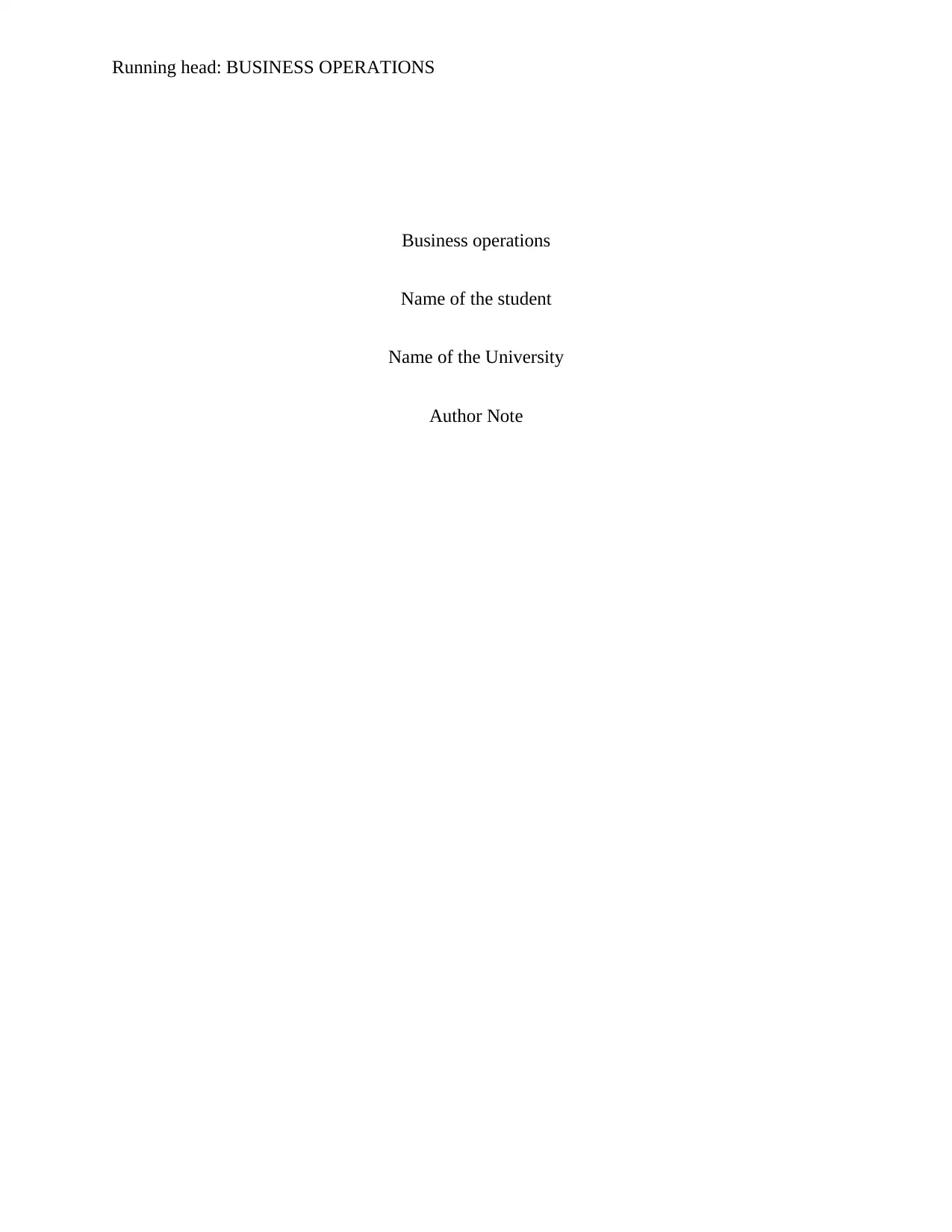
Running head: BUSINESS OPERATIONS
Business operations
Name of the student
Name of the University
Author Note
Business operations
Name of the student
Name of the University
Author Note
Paraphrase This Document
Need a fresh take? Get an instant paraphrase of this document with our AI Paraphraser
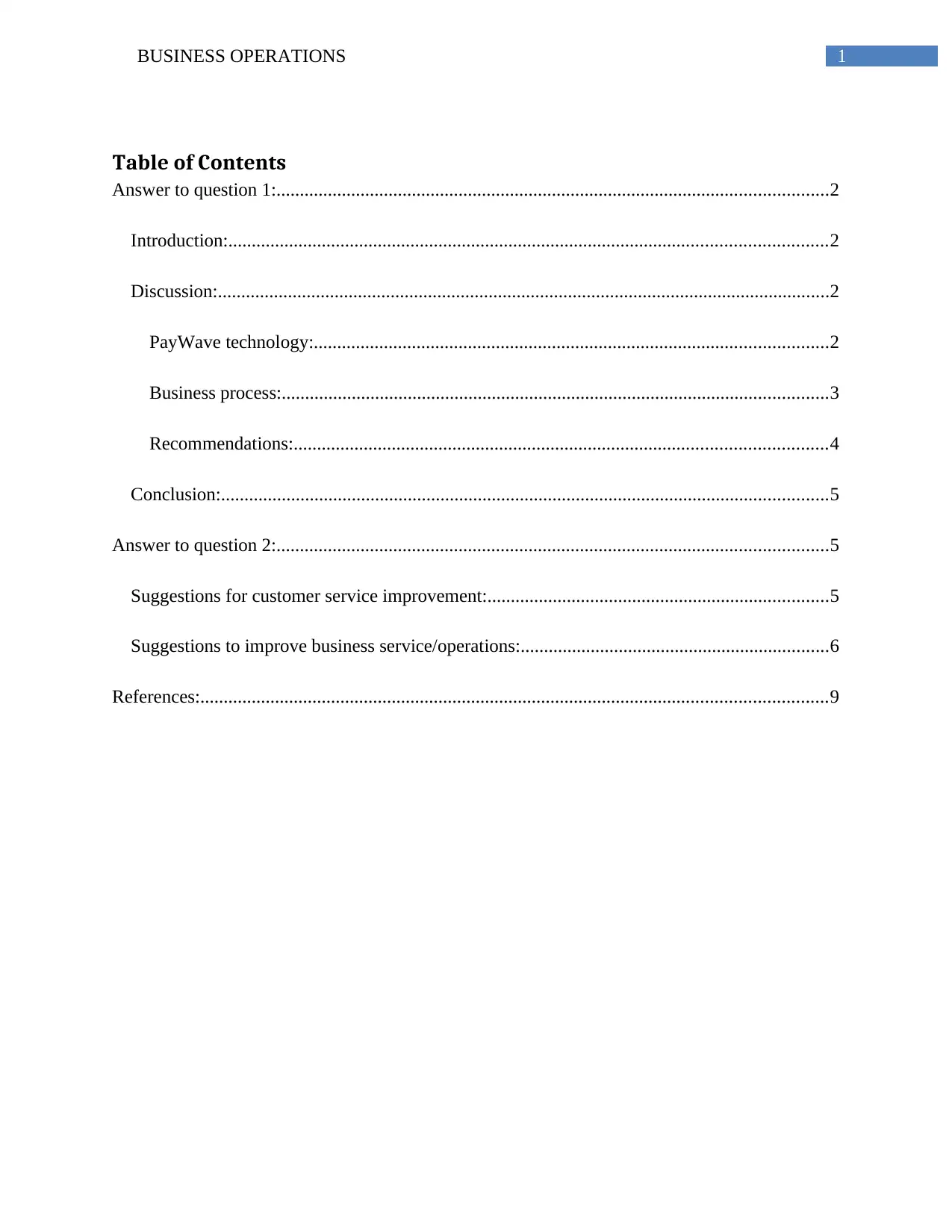
1BUSINESS OPERATIONS
Table of Contents
Answer to question 1:......................................................................................................................2
Introduction:................................................................................................................................2
Discussion:...................................................................................................................................2
PayWave technology:..............................................................................................................2
Business process:.....................................................................................................................3
Recommendations:..................................................................................................................4
Conclusion:..................................................................................................................................5
Answer to question 2:......................................................................................................................5
Suggestions for customer service improvement:.........................................................................5
Suggestions to improve business service/operations:..................................................................6
References:......................................................................................................................................9
Table of Contents
Answer to question 1:......................................................................................................................2
Introduction:................................................................................................................................2
Discussion:...................................................................................................................................2
PayWave technology:..............................................................................................................2
Business process:.....................................................................................................................3
Recommendations:..................................................................................................................4
Conclusion:..................................................................................................................................5
Answer to question 2:......................................................................................................................5
Suggestions for customer service improvement:.........................................................................5
Suggestions to improve business service/operations:..................................................................6
References:......................................................................................................................................9
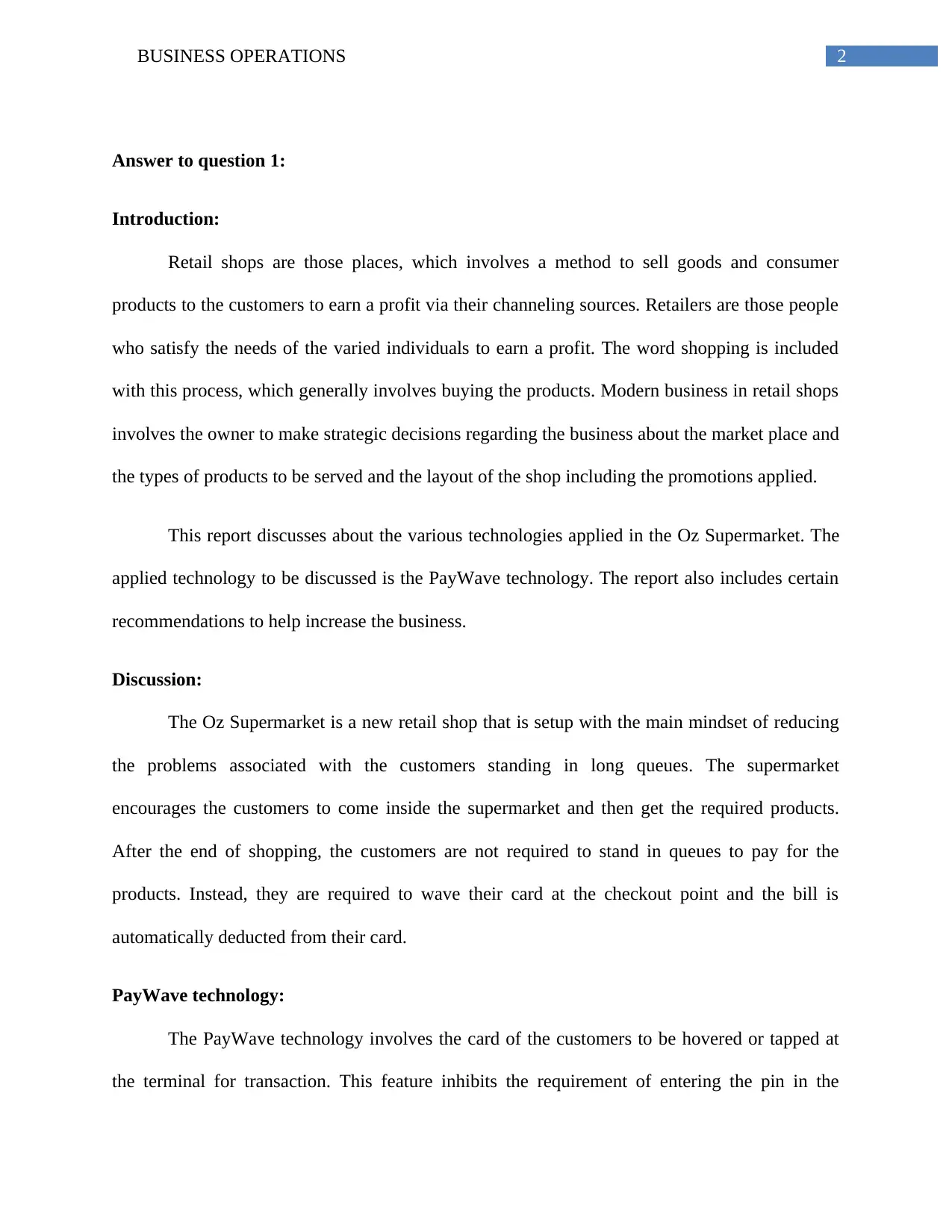
2BUSINESS OPERATIONS
Answer to question 1:
Introduction:
Retail shops are those places, which involves a method to sell goods and consumer
products to the customers to earn a profit via their channeling sources. Retailers are those people
who satisfy the needs of the varied individuals to earn a profit. The word shopping is included
with this process, which generally involves buying the products. Modern business in retail shops
involves the owner to make strategic decisions regarding the business about the market place and
the types of products to be served and the layout of the shop including the promotions applied.
This report discusses about the various technologies applied in the Oz Supermarket. The
applied technology to be discussed is the PayWave technology. The report also includes certain
recommendations to help increase the business.
Discussion:
The Oz Supermarket is a new retail shop that is setup with the main mindset of reducing
the problems associated with the customers standing in long queues. The supermarket
encourages the customers to come inside the supermarket and then get the required products.
After the end of shopping, the customers are not required to stand in queues to pay for the
products. Instead, they are required to wave their card at the checkout point and the bill is
automatically deducted from their card.
PayWave technology:
The PayWave technology involves the card of the customers to be hovered or tapped at
the terminal for transaction. This feature inhibits the requirement of entering the pin in the
Answer to question 1:
Introduction:
Retail shops are those places, which involves a method to sell goods and consumer
products to the customers to earn a profit via their channeling sources. Retailers are those people
who satisfy the needs of the varied individuals to earn a profit. The word shopping is included
with this process, which generally involves buying the products. Modern business in retail shops
involves the owner to make strategic decisions regarding the business about the market place and
the types of products to be served and the layout of the shop including the promotions applied.
This report discusses about the various technologies applied in the Oz Supermarket. The
applied technology to be discussed is the PayWave technology. The report also includes certain
recommendations to help increase the business.
Discussion:
The Oz Supermarket is a new retail shop that is setup with the main mindset of reducing
the problems associated with the customers standing in long queues. The supermarket
encourages the customers to come inside the supermarket and then get the required products.
After the end of shopping, the customers are not required to stand in queues to pay for the
products. Instead, they are required to wave their card at the checkout point and the bill is
automatically deducted from their card.
PayWave technology:
The PayWave technology involves the card of the customers to be hovered or tapped at
the terminal for transaction. This feature inhibits the requirement of entering the pin in the
⊘ This is a preview!⊘
Do you want full access?
Subscribe today to unlock all pages.

Trusted by 1+ million students worldwide
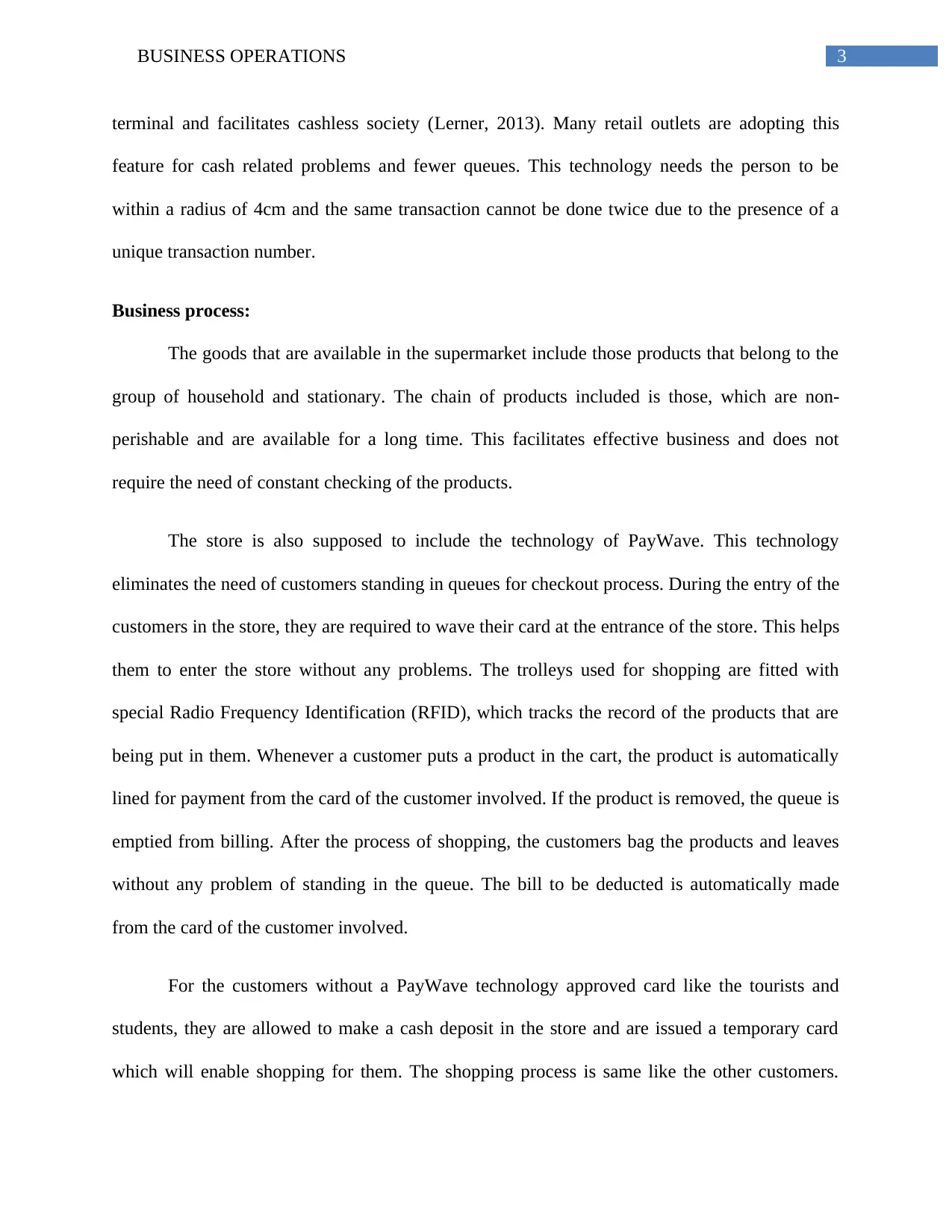
3BUSINESS OPERATIONS
terminal and facilitates cashless society (Lerner, 2013). Many retail outlets are adopting this
feature for cash related problems and fewer queues. This technology needs the person to be
within a radius of 4cm and the same transaction cannot be done twice due to the presence of a
unique transaction number.
Business process:
The goods that are available in the supermarket include those products that belong to the
group of household and stationary. The chain of products included is those, which are non-
perishable and are available for a long time. This facilitates effective business and does not
require the need of constant checking of the products.
The store is also supposed to include the technology of PayWave. This technology
eliminates the need of customers standing in queues for checkout process. During the entry of the
customers in the store, they are required to wave their card at the entrance of the store. This helps
them to enter the store without any problems. The trolleys used for shopping are fitted with
special Radio Frequency Identification (RFID), which tracks the record of the products that are
being put in them. Whenever a customer puts a product in the cart, the product is automatically
lined for payment from the card of the customer involved. If the product is removed, the queue is
emptied from billing. After the process of shopping, the customers bag the products and leaves
without any problem of standing in the queue. The bill to be deducted is automatically made
from the card of the customer involved.
For the customers without a PayWave technology approved card like the tourists and
students, they are allowed to make a cash deposit in the store and are issued a temporary card
which will enable shopping for them. The shopping process is same like the other customers.
terminal and facilitates cashless society (Lerner, 2013). Many retail outlets are adopting this
feature for cash related problems and fewer queues. This technology needs the person to be
within a radius of 4cm and the same transaction cannot be done twice due to the presence of a
unique transaction number.
Business process:
The goods that are available in the supermarket include those products that belong to the
group of household and stationary. The chain of products included is those, which are non-
perishable and are available for a long time. This facilitates effective business and does not
require the need of constant checking of the products.
The store is also supposed to include the technology of PayWave. This technology
eliminates the need of customers standing in queues for checkout process. During the entry of the
customers in the store, they are required to wave their card at the entrance of the store. This helps
them to enter the store without any problems. The trolleys used for shopping are fitted with
special Radio Frequency Identification (RFID), which tracks the record of the products that are
being put in them. Whenever a customer puts a product in the cart, the product is automatically
lined for payment from the card of the customer involved. If the product is removed, the queue is
emptied from billing. After the process of shopping, the customers bag the products and leaves
without any problem of standing in the queue. The bill to be deducted is automatically made
from the card of the customer involved.
For the customers without a PayWave technology approved card like the tourists and
students, they are allowed to make a cash deposit in the store and are issued a temporary card
which will enable shopping for them. The shopping process is same like the other customers.
Paraphrase This Document
Need a fresh take? Get an instant paraphrase of this document with our AI Paraphraser
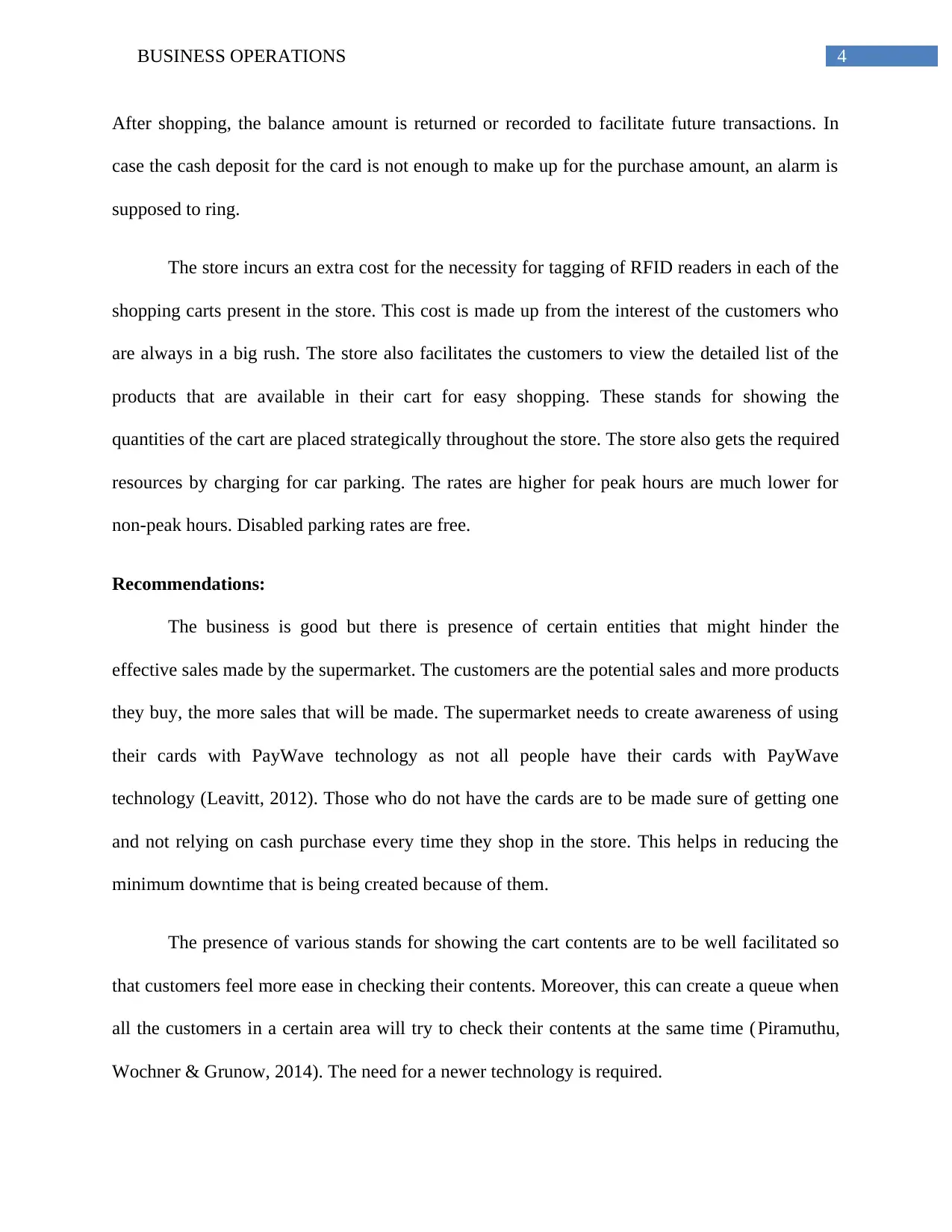
4BUSINESS OPERATIONS
After shopping, the balance amount is returned or recorded to facilitate future transactions. In
case the cash deposit for the card is not enough to make up for the purchase amount, an alarm is
supposed to ring.
The store incurs an extra cost for the necessity for tagging of RFID readers in each of the
shopping carts present in the store. This cost is made up from the interest of the customers who
are always in a big rush. The store also facilitates the customers to view the detailed list of the
products that are available in their cart for easy shopping. These stands for showing the
quantities of the cart are placed strategically throughout the store. The store also gets the required
resources by charging for car parking. The rates are higher for peak hours are much lower for
non-peak hours. Disabled parking rates are free.
Recommendations:
The business is good but there is presence of certain entities that might hinder the
effective sales made by the supermarket. The customers are the potential sales and more products
they buy, the more sales that will be made. The supermarket needs to create awareness of using
their cards with PayWave technology as not all people have their cards with PayWave
technology (Leavitt, 2012). Those who do not have the cards are to be made sure of getting one
and not relying on cash purchase every time they shop in the store. This helps in reducing the
minimum downtime that is being created because of them.
The presence of various stands for showing the cart contents are to be well facilitated so
that customers feel more ease in checking their contents. Moreover, this can create a queue when
all the customers in a certain area will try to check their contents at the same time (Piramuthu,
Wochner & Grunow, 2014). The need for a newer technology is required.
After shopping, the balance amount is returned or recorded to facilitate future transactions. In
case the cash deposit for the card is not enough to make up for the purchase amount, an alarm is
supposed to ring.
The store incurs an extra cost for the necessity for tagging of RFID readers in each of the
shopping carts present in the store. This cost is made up from the interest of the customers who
are always in a big rush. The store also facilitates the customers to view the detailed list of the
products that are available in their cart for easy shopping. These stands for showing the
quantities of the cart are placed strategically throughout the store. The store also gets the required
resources by charging for car parking. The rates are higher for peak hours are much lower for
non-peak hours. Disabled parking rates are free.
Recommendations:
The business is good but there is presence of certain entities that might hinder the
effective sales made by the supermarket. The customers are the potential sales and more products
they buy, the more sales that will be made. The supermarket needs to create awareness of using
their cards with PayWave technology as not all people have their cards with PayWave
technology (Leavitt, 2012). Those who do not have the cards are to be made sure of getting one
and not relying on cash purchase every time they shop in the store. This helps in reducing the
minimum downtime that is being created because of them.
The presence of various stands for showing the cart contents are to be well facilitated so
that customers feel more ease in checking their contents. Moreover, this can create a queue when
all the customers in a certain area will try to check their contents at the same time (Piramuthu,
Wochner & Grunow, 2014). The need for a newer technology is required.
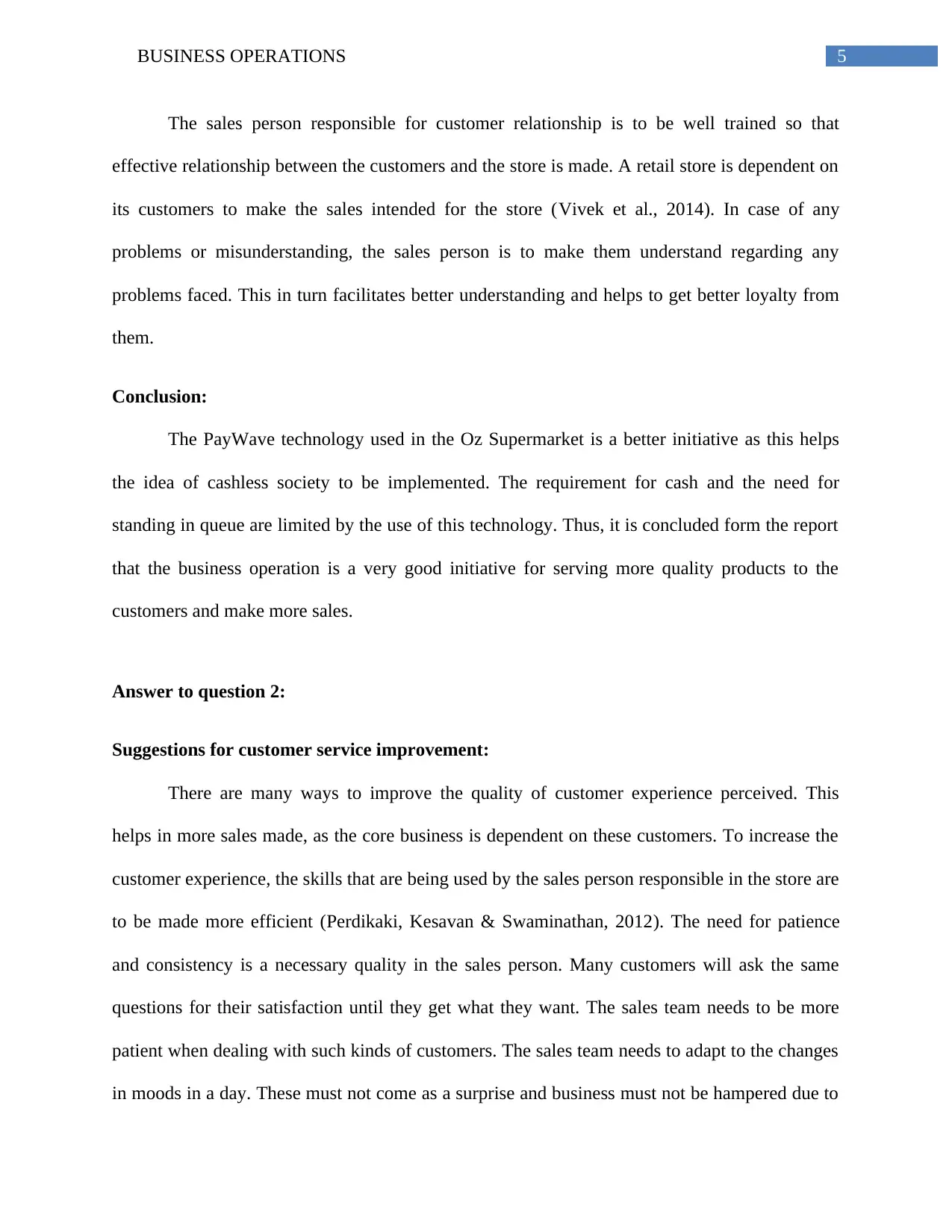
5BUSINESS OPERATIONS
The sales person responsible for customer relationship is to be well trained so that
effective relationship between the customers and the store is made. A retail store is dependent on
its customers to make the sales intended for the store (Vivek et al., 2014). In case of any
problems or misunderstanding, the sales person is to make them understand regarding any
problems faced. This in turn facilitates better understanding and helps to get better loyalty from
them.
Conclusion:
The PayWave technology used in the Oz Supermarket is a better initiative as this helps
the idea of cashless society to be implemented. The requirement for cash and the need for
standing in queue are limited by the use of this technology. Thus, it is concluded form the report
that the business operation is a very good initiative for serving more quality products to the
customers and make more sales.
Answer to question 2:
Suggestions for customer service improvement:
There are many ways to improve the quality of customer experience perceived. This
helps in more sales made, as the core business is dependent on these customers. To increase the
customer experience, the skills that are being used by the sales person responsible in the store are
to be made more efficient (Perdikaki, Kesavan & Swaminathan, 2012). The need for patience
and consistency is a necessary quality in the sales person. Many customers will ask the same
questions for their satisfaction until they get what they want. The sales team needs to be more
patient when dealing with such kinds of customers. The sales team needs to adapt to the changes
in moods in a day. These must not come as a surprise and business must not be hampered due to
The sales person responsible for customer relationship is to be well trained so that
effective relationship between the customers and the store is made. A retail store is dependent on
its customers to make the sales intended for the store (Vivek et al., 2014). In case of any
problems or misunderstanding, the sales person is to make them understand regarding any
problems faced. This in turn facilitates better understanding and helps to get better loyalty from
them.
Conclusion:
The PayWave technology used in the Oz Supermarket is a better initiative as this helps
the idea of cashless society to be implemented. The requirement for cash and the need for
standing in queue are limited by the use of this technology. Thus, it is concluded form the report
that the business operation is a very good initiative for serving more quality products to the
customers and make more sales.
Answer to question 2:
Suggestions for customer service improvement:
There are many ways to improve the quality of customer experience perceived. This
helps in more sales made, as the core business is dependent on these customers. To increase the
customer experience, the skills that are being used by the sales person responsible in the store are
to be made more efficient (Perdikaki, Kesavan & Swaminathan, 2012). The need for patience
and consistency is a necessary quality in the sales person. Many customers will ask the same
questions for their satisfaction until they get what they want. The sales team needs to be more
patient when dealing with such kinds of customers. The sales team needs to adapt to the changes
in moods in a day. These must not come as a surprise and business must not be hampered due to
⊘ This is a preview!⊘
Do you want full access?
Subscribe today to unlock all pages.

Trusted by 1+ million students worldwide
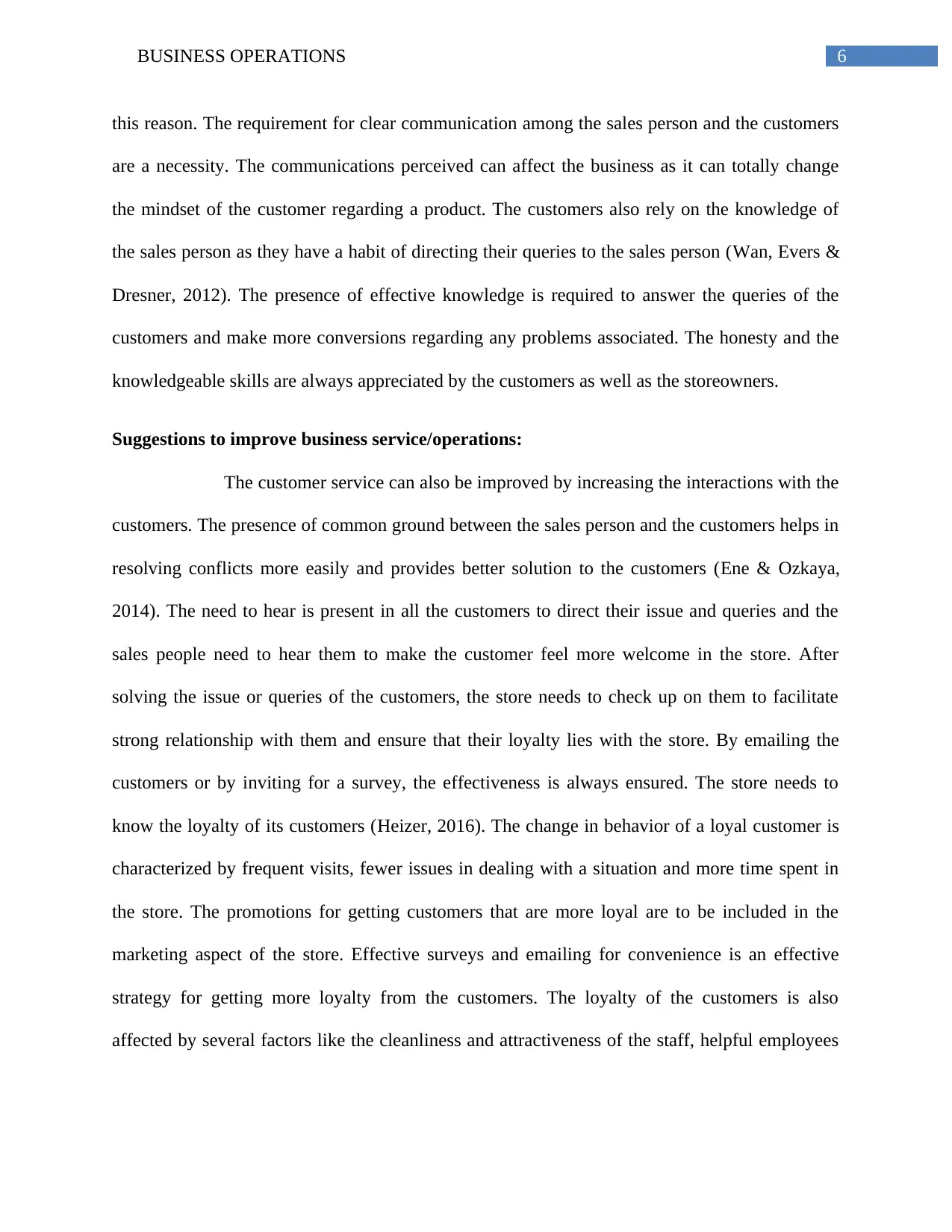
6BUSINESS OPERATIONS
this reason. The requirement for clear communication among the sales person and the customers
are a necessity. The communications perceived can affect the business as it can totally change
the mindset of the customer regarding a product. The customers also rely on the knowledge of
the sales person as they have a habit of directing their queries to the sales person (Wan, Evers &
Dresner, 2012). The presence of effective knowledge is required to answer the queries of the
customers and make more conversions regarding any problems associated. The honesty and the
knowledgeable skills are always appreciated by the customers as well as the storeowners.
Suggestions to improve business service/operations:
The customer service can also be improved by increasing the interactions with the
customers. The presence of common ground between the sales person and the customers helps in
resolving conflicts more easily and provides better solution to the customers (Ene & Ozkaya,
2014). The need to hear is present in all the customers to direct their issue and queries and the
sales people need to hear them to make the customer feel more welcome in the store. After
solving the issue or queries of the customers, the store needs to check up on them to facilitate
strong relationship with them and ensure that their loyalty lies with the store. By emailing the
customers or by inviting for a survey, the effectiveness is always ensured. The store needs to
know the loyalty of its customers (Heizer, 2016). The change in behavior of a loyal customer is
characterized by frequent visits, fewer issues in dealing with a situation and more time spent in
the store. The promotions for getting customers that are more loyal are to be included in the
marketing aspect of the store. Effective surveys and emailing for convenience is an effective
strategy for getting more loyalty from the customers. The loyalty of the customers is also
affected by several factors like the cleanliness and attractiveness of the staff, helpful employees
this reason. The requirement for clear communication among the sales person and the customers
are a necessity. The communications perceived can affect the business as it can totally change
the mindset of the customer regarding a product. The customers also rely on the knowledge of
the sales person as they have a habit of directing their queries to the sales person (Wan, Evers &
Dresner, 2012). The presence of effective knowledge is required to answer the queries of the
customers and make more conversions regarding any problems associated. The honesty and the
knowledgeable skills are always appreciated by the customers as well as the storeowners.
Suggestions to improve business service/operations:
The customer service can also be improved by increasing the interactions with the
customers. The presence of common ground between the sales person and the customers helps in
resolving conflicts more easily and provides better solution to the customers (Ene & Ozkaya,
2014). The need to hear is present in all the customers to direct their issue and queries and the
sales people need to hear them to make the customer feel more welcome in the store. After
solving the issue or queries of the customers, the store needs to check up on them to facilitate
strong relationship with them and ensure that their loyalty lies with the store. By emailing the
customers or by inviting for a survey, the effectiveness is always ensured. The store needs to
know the loyalty of its customers (Heizer, 2016). The change in behavior of a loyal customer is
characterized by frequent visits, fewer issues in dealing with a situation and more time spent in
the store. The promotions for getting customers that are more loyal are to be included in the
marketing aspect of the store. Effective surveys and emailing for convenience is an effective
strategy for getting more loyalty from the customers. The loyalty of the customers is also
affected by several factors like the cleanliness and attractiveness of the staff, helpful employees
Paraphrase This Document
Need a fresh take? Get an instant paraphrase of this document with our AI Paraphraser
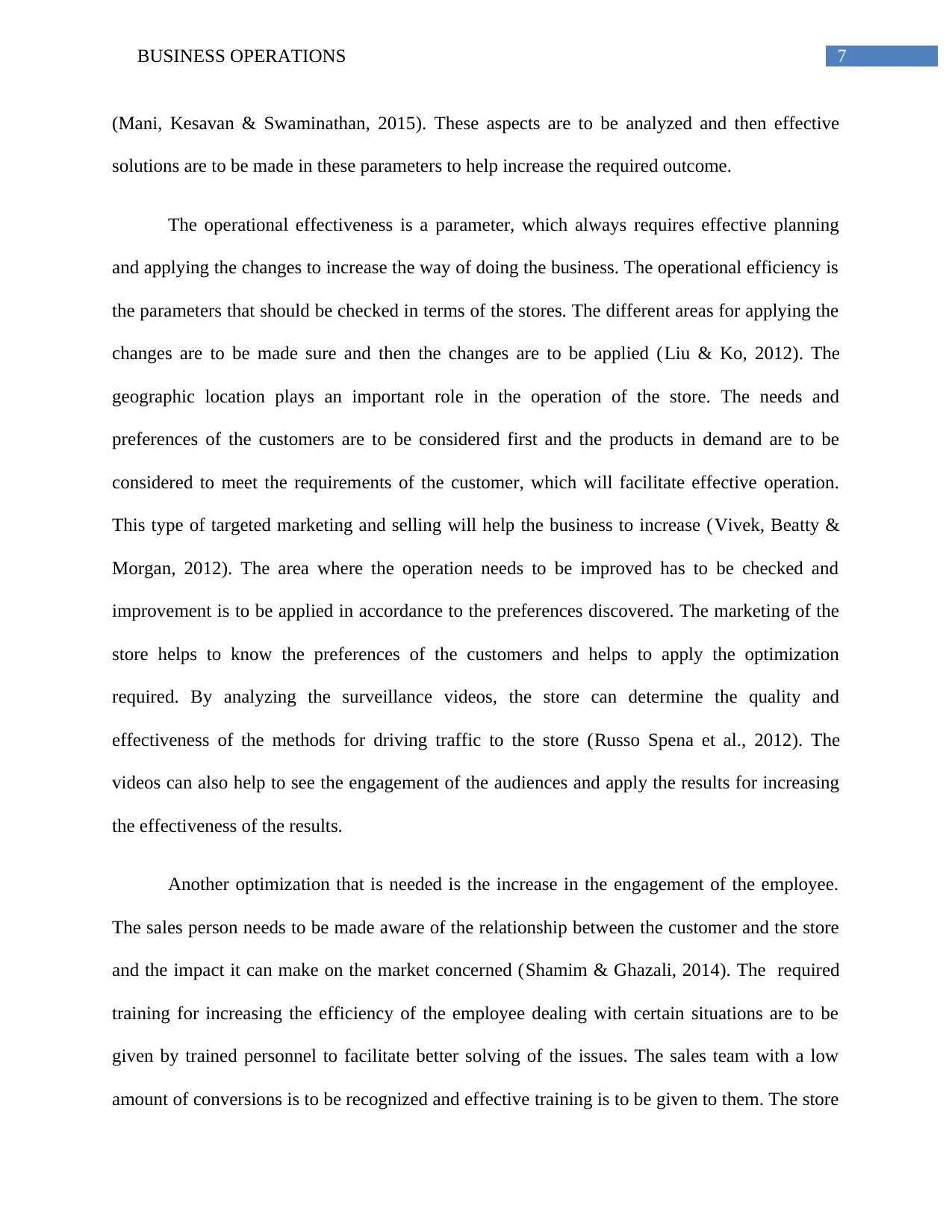
7BUSINESS OPERATIONS
(Mani, Kesavan & Swaminathan, 2015). These aspects are to be analyzed and then effective
solutions are to be made in these parameters to help increase the required outcome.
The operational effectiveness is a parameter, which always requires effective planning
and applying the changes to increase the way of doing the business. The operational efficiency is
the parameters that should be checked in terms of the stores. The different areas for applying the
changes are to be made sure and then the changes are to be applied (Liu & Ko, 2012). The
geographic location plays an important role in the operation of the store. The needs and
preferences of the customers are to be considered first and the products in demand are to be
considered to meet the requirements of the customer, which will facilitate effective operation.
This type of targeted marketing and selling will help the business to increase (Vivek, Beatty &
Morgan, 2012). The area where the operation needs to be improved has to be checked and
improvement is to be applied in accordance to the preferences discovered. The marketing of the
store helps to know the preferences of the customers and helps to apply the optimization
required. By analyzing the surveillance videos, the store can determine the quality and
effectiveness of the methods for driving traffic to the store (Russo Spena et al., 2012). The
videos can also help to see the engagement of the audiences and apply the results for increasing
the effectiveness of the results.
Another optimization that is needed is the increase in the engagement of the employee.
The sales person needs to be made aware of the relationship between the customer and the store
and the impact it can make on the market concerned (Shamim & Ghazali, 2014). The required
training for increasing the efficiency of the employee dealing with certain situations are to be
given by trained personnel to facilitate better solving of the issues. The sales team with a low
amount of conversions is to be recognized and effective training is to be given to them. The store
(Mani, Kesavan & Swaminathan, 2015). These aspects are to be analyzed and then effective
solutions are to be made in these parameters to help increase the required outcome.
The operational effectiveness is a parameter, which always requires effective planning
and applying the changes to increase the way of doing the business. The operational efficiency is
the parameters that should be checked in terms of the stores. The different areas for applying the
changes are to be made sure and then the changes are to be applied (Liu & Ko, 2012). The
geographic location plays an important role in the operation of the store. The needs and
preferences of the customers are to be considered first and the products in demand are to be
considered to meet the requirements of the customer, which will facilitate effective operation.
This type of targeted marketing and selling will help the business to increase (Vivek, Beatty &
Morgan, 2012). The area where the operation needs to be improved has to be checked and
improvement is to be applied in accordance to the preferences discovered. The marketing of the
store helps to know the preferences of the customers and helps to apply the optimization
required. By analyzing the surveillance videos, the store can determine the quality and
effectiveness of the methods for driving traffic to the store (Russo Spena et al., 2012). The
videos can also help to see the engagement of the audiences and apply the results for increasing
the effectiveness of the results.
Another optimization that is needed is the increase in the engagement of the employee.
The sales person needs to be made aware of the relationship between the customer and the store
and the impact it can make on the market concerned (Shamim & Ghazali, 2014). The required
training for increasing the efficiency of the employee dealing with certain situations are to be
given by trained personnel to facilitate better solving of the issues. The sales team with a low
amount of conversions is to be recognized and effective training is to be given to them. The store
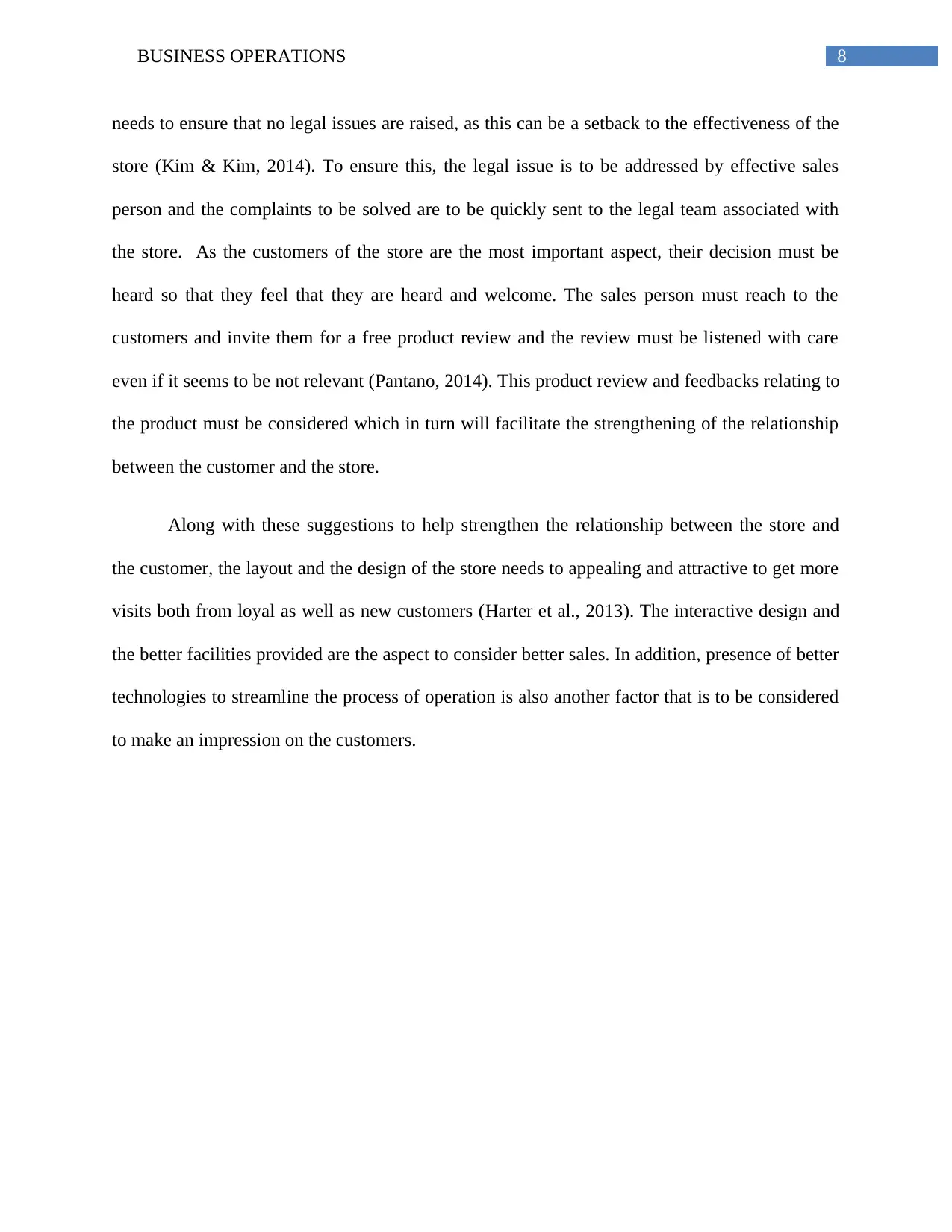
8BUSINESS OPERATIONS
needs to ensure that no legal issues are raised, as this can be a setback to the effectiveness of the
store (Kim & Kim, 2014). To ensure this, the legal issue is to be addressed by effective sales
person and the complaints to be solved are to be quickly sent to the legal team associated with
the store. As the customers of the store are the most important aspect, their decision must be
heard so that they feel that they are heard and welcome. The sales person must reach to the
customers and invite them for a free product review and the review must be listened with care
even if it seems to be not relevant (Pantano, 2014). This product review and feedbacks relating to
the product must be considered which in turn will facilitate the strengthening of the relationship
between the customer and the store.
Along with these suggestions to help strengthen the relationship between the store and
the customer, the layout and the design of the store needs to appealing and attractive to get more
visits both from loyal as well as new customers (Harter et al., 2013). The interactive design and
the better facilities provided are the aspect to consider better sales. In addition, presence of better
technologies to streamline the process of operation is also another factor that is to be considered
to make an impression on the customers.
needs to ensure that no legal issues are raised, as this can be a setback to the effectiveness of the
store (Kim & Kim, 2014). To ensure this, the legal issue is to be addressed by effective sales
person and the complaints to be solved are to be quickly sent to the legal team associated with
the store. As the customers of the store are the most important aspect, their decision must be
heard so that they feel that they are heard and welcome. The sales person must reach to the
customers and invite them for a free product review and the review must be listened with care
even if it seems to be not relevant (Pantano, 2014). This product review and feedbacks relating to
the product must be considered which in turn will facilitate the strengthening of the relationship
between the customer and the store.
Along with these suggestions to help strengthen the relationship between the store and
the customer, the layout and the design of the store needs to appealing and attractive to get more
visits both from loyal as well as new customers (Harter et al., 2013). The interactive design and
the better facilities provided are the aspect to consider better sales. In addition, presence of better
technologies to streamline the process of operation is also another factor that is to be considered
to make an impression on the customers.
⊘ This is a preview!⊘
Do you want full access?
Subscribe today to unlock all pages.

Trusted by 1+ million students worldwide
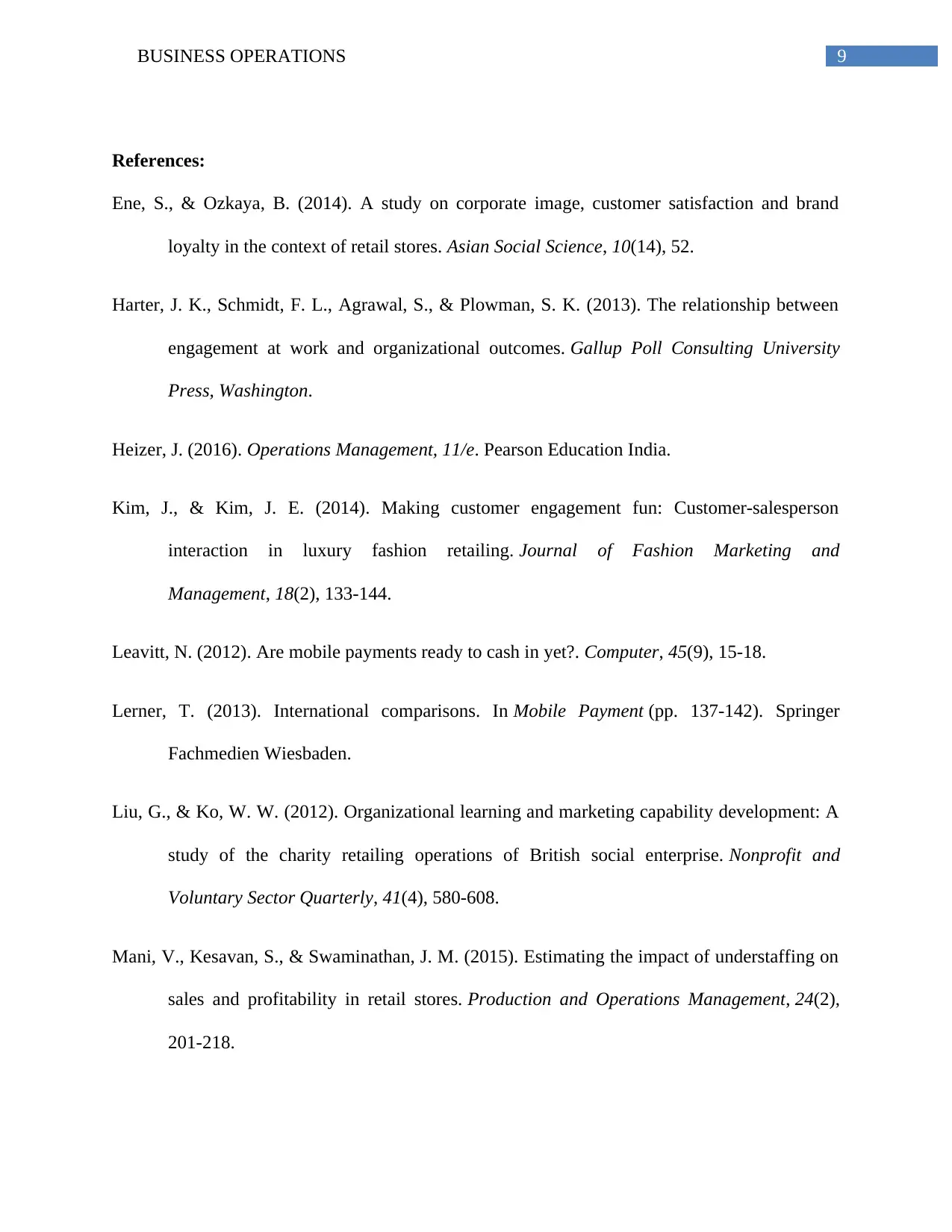
9BUSINESS OPERATIONS
References:
Ene, S., & Ozkaya, B. (2014). A study on corporate image, customer satisfaction and brand
loyalty in the context of retail stores. Asian Social Science, 10(14), 52.
Harter, J. K., Schmidt, F. L., Agrawal, S., & Plowman, S. K. (2013). The relationship between
engagement at work and organizational outcomes. Gallup Poll Consulting University
Press, Washington.
Heizer, J. (2016). Operations Management, 11/e. Pearson Education India.
Kim, J., & Kim, J. E. (2014). Making customer engagement fun: Customer-salesperson
interaction in luxury fashion retailing. Journal of Fashion Marketing and
Management, 18(2), 133-144.
Leavitt, N. (2012). Are mobile payments ready to cash in yet?. Computer, 45(9), 15-18.
Lerner, T. (2013). International comparisons. In Mobile Payment (pp. 137-142). Springer
Fachmedien Wiesbaden.
Liu, G., & Ko, W. W. (2012). Organizational learning and marketing capability development: A
study of the charity retailing operations of British social enterprise. Nonprofit and
Voluntary Sector Quarterly, 41(4), 580-608.
Mani, V., Kesavan, S., & Swaminathan, J. M. (2015). Estimating the impact of understaffing on
sales and profitability in retail stores. Production and Operations Management, 24(2),
201-218.
References:
Ene, S., & Ozkaya, B. (2014). A study on corporate image, customer satisfaction and brand
loyalty in the context of retail stores. Asian Social Science, 10(14), 52.
Harter, J. K., Schmidt, F. L., Agrawal, S., & Plowman, S. K. (2013). The relationship between
engagement at work and organizational outcomes. Gallup Poll Consulting University
Press, Washington.
Heizer, J. (2016). Operations Management, 11/e. Pearson Education India.
Kim, J., & Kim, J. E. (2014). Making customer engagement fun: Customer-salesperson
interaction in luxury fashion retailing. Journal of Fashion Marketing and
Management, 18(2), 133-144.
Leavitt, N. (2012). Are mobile payments ready to cash in yet?. Computer, 45(9), 15-18.
Lerner, T. (2013). International comparisons. In Mobile Payment (pp. 137-142). Springer
Fachmedien Wiesbaden.
Liu, G., & Ko, W. W. (2012). Organizational learning and marketing capability development: A
study of the charity retailing operations of British social enterprise. Nonprofit and
Voluntary Sector Quarterly, 41(4), 580-608.
Mani, V., Kesavan, S., & Swaminathan, J. M. (2015). Estimating the impact of understaffing on
sales and profitability in retail stores. Production and Operations Management, 24(2),
201-218.
Paraphrase This Document
Need a fresh take? Get an instant paraphrase of this document with our AI Paraphraser
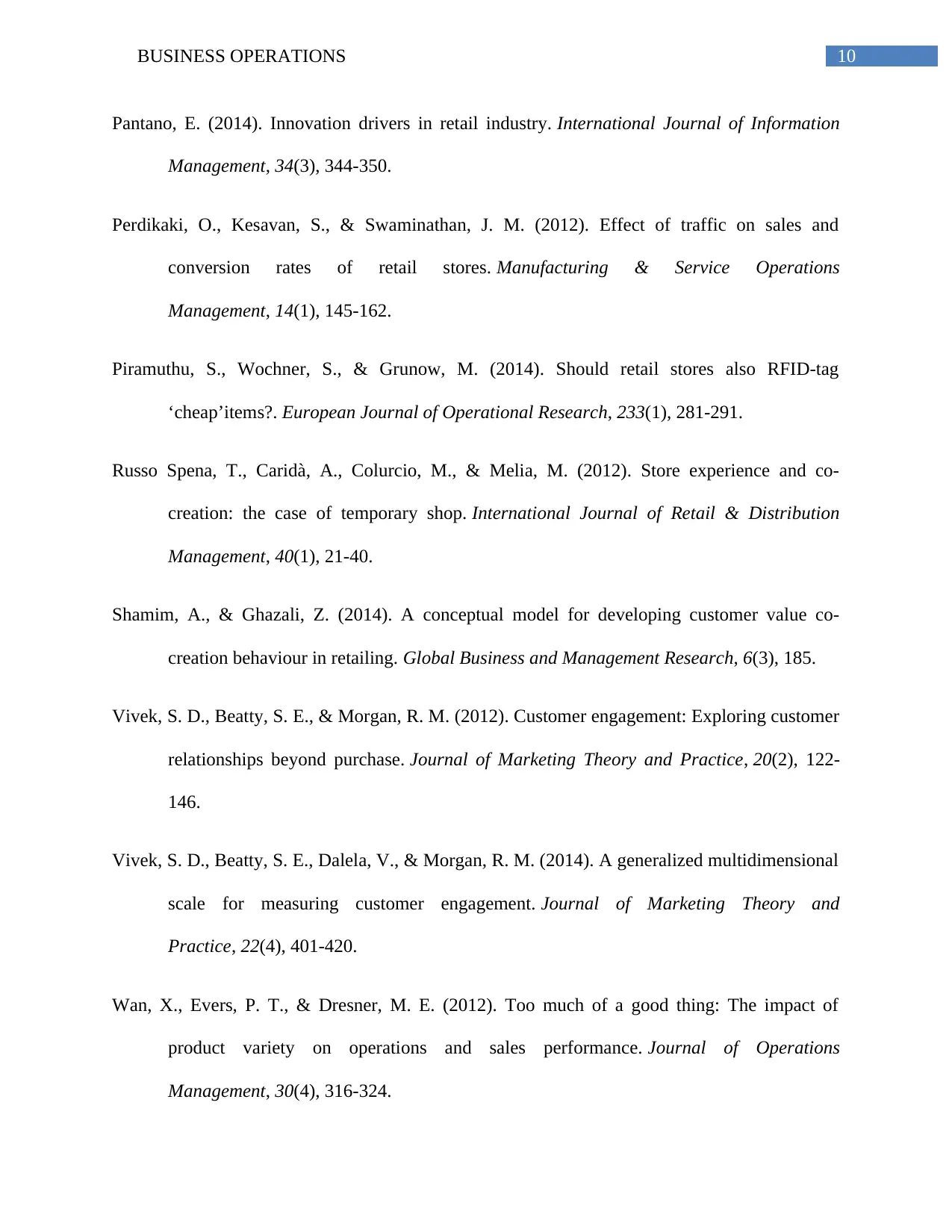
10BUSINESS OPERATIONS
Pantano, E. (2014). Innovation drivers in retail industry. International Journal of Information
Management, 34(3), 344-350.
Perdikaki, O., Kesavan, S., & Swaminathan, J. M. (2012). Effect of traffic on sales and
conversion rates of retail stores. Manufacturing & Service Operations
Management, 14(1), 145-162.
Piramuthu, S., Wochner, S., & Grunow, M. (2014). Should retail stores also RFID-tag
‘cheap’items?. European Journal of Operational Research, 233(1), 281-291.
Russo Spena, T., Caridà, A., Colurcio, M., & Melia, M. (2012). Store experience and co-
creation: the case of temporary shop. International Journal of Retail & Distribution
Management, 40(1), 21-40.
Shamim, A., & Ghazali, Z. (2014). A conceptual model for developing customer value co-
creation behaviour in retailing. Global Business and Management Research, 6(3), 185.
Vivek, S. D., Beatty, S. E., & Morgan, R. M. (2012). Customer engagement: Exploring customer
relationships beyond purchase. Journal of Marketing Theory and Practice, 20(2), 122-
146.
Vivek, S. D., Beatty, S. E., Dalela, V., & Morgan, R. M. (2014). A generalized multidimensional
scale for measuring customer engagement. Journal of Marketing Theory and
Practice, 22(4), 401-420.
Wan, X., Evers, P. T., & Dresner, M. E. (2012). Too much of a good thing: The impact of
product variety on operations and sales performance. Journal of Operations
Management, 30(4), 316-324.
Pantano, E. (2014). Innovation drivers in retail industry. International Journal of Information
Management, 34(3), 344-350.
Perdikaki, O., Kesavan, S., & Swaminathan, J. M. (2012). Effect of traffic on sales and
conversion rates of retail stores. Manufacturing & Service Operations
Management, 14(1), 145-162.
Piramuthu, S., Wochner, S., & Grunow, M. (2014). Should retail stores also RFID-tag
‘cheap’items?. European Journal of Operational Research, 233(1), 281-291.
Russo Spena, T., Caridà, A., Colurcio, M., & Melia, M. (2012). Store experience and co-
creation: the case of temporary shop. International Journal of Retail & Distribution
Management, 40(1), 21-40.
Shamim, A., & Ghazali, Z. (2014). A conceptual model for developing customer value co-
creation behaviour in retailing. Global Business and Management Research, 6(3), 185.
Vivek, S. D., Beatty, S. E., & Morgan, R. M. (2012). Customer engagement: Exploring customer
relationships beyond purchase. Journal of Marketing Theory and Practice, 20(2), 122-
146.
Vivek, S. D., Beatty, S. E., Dalela, V., & Morgan, R. M. (2014). A generalized multidimensional
scale for measuring customer engagement. Journal of Marketing Theory and
Practice, 22(4), 401-420.
Wan, X., Evers, P. T., & Dresner, M. E. (2012). Too much of a good thing: The impact of
product variety on operations and sales performance. Journal of Operations
Management, 30(4), 316-324.

11BUSINESS OPERATIONS
⊘ This is a preview!⊘
Do you want full access?
Subscribe today to unlock all pages.

Trusted by 1+ million students worldwide
1 out of 12
Related Documents
Your All-in-One AI-Powered Toolkit for Academic Success.
+13062052269
info@desklib.com
Available 24*7 on WhatsApp / Email
![[object Object]](/_next/static/media/star-bottom.7253800d.svg)
Unlock your academic potential
Copyright © 2020–2025 A2Z Services. All Rights Reserved. Developed and managed by ZUCOL.





